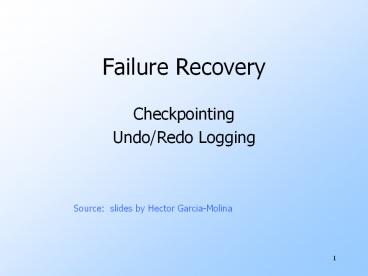Failure Recovery - PowerPoint PPT Presentation
Title:
Failure Recovery
Description:
Buffer containing X can be flushed to disk either before or after T commits ... write to disk all dirty buffers (contain a changed DB element), whether or not ... – PowerPoint PPT presentation
Number of Views:20
Avg rating:3.0/5.0
Title: Failure Recovery
1
Failure Recovery
- Checkpointing
- Undo/Redo Logging
Source slides by Hector Garcia-Molina
2
Recovery is very, very SLOW !
- Redo log
- First T1 wrote A,B Last
- Record Committed a year ago Record
- (1 year ago) --gt STILL, Need to redo after crash!!
...
...
...
Crash
3
Solution Checkpoint (simple version)
- Periodically
- (1) Do not accept new transactions
- (2) Wait until all transactions finish
- (3) Flush all log records to disk (log)
- (4) Flush all buffers to disk (DB) (do not
discard buffers) - (5) Write checkpoint record on disk (log)
- (6) Resume transaction processing
4
Example what to do at recovery?
- Redo log (disk)
Crash
...
...
...
...
...
...
Start from last checkpoint and move forward in
the log file redoing updates for
committed transactions.
5
Key drawbacks
- Undo logging data must be written to disk
immediately after a transaction finishes, which
can increase number of disk I/O's - Redo logging need to keep all modified blocks in
memory until transaction commits and log is
flushed, which can increase the number of buffers
required
6
Solution undo/redo logging!
- Update record in the log has the format
- ltT, X, new X val, old X valgt
7
Rules
- Buffer containing X can be flushed to disk either
before or after T commits - Log record must be flushed to disk before
corresponding updated buffer is (WAL)
8
Recovery with Undo/Redo Logging
- Redo all committed transactions in order from
earliest to latest - handles committed transactions with some changes
not yet on disk - Undo all incomplete transactions in order from
latest to earliest - handles uncommitted transactions with some
chnages already on disk
9
Non-quiescent Checkpoint
- Simple checkpointing scheme requires system to
"quiesce" (reach a point with no active
transactions), ensured by preventing new
transactions from starting for a while - Avoid this behavior with non-quiescent
checkpointing - write a "start checkpoint" record to the log
- later write an "end checkpoint" record to the log
- Details vary depending on whether undo, redo, or
undo/redo logging
10
Non-quiescent Checkpoint for Undo/Redo
- write "start checkpoint" listing all active
transactions to log - flush log to disk
- write to disk all dirty buffers (contain a
changed DB element), whether or not transaction
has committed - this implies some log records may need to be
written to disk (WAL) - write "end checkpoint" to log
- flush log to disk
11
Non-quiescent checkpoint for undo/redo
- L
- O
- G
- for
- undo dirty buffer
- pool pages
- flushed
start ckpt active T's T1,T2,...
end ckpt
...
...
...
...
12
Recovery process
- Backwards pass (end of log ? latest checkpoint
start) - construct set S of committed transactions
- undo actions of transactions not in S
- Undo pending transactions
- follow undo chains for transactions in
(checkpoint active list) - S - Forward pass (latest checkpoint start ? end of
log) - redo actions of S transactions
backward pass
start check- point
forward pass
13
Examples what to do at recovery time?
- no T1 commit
- L
- O
- G
T1,- a
...
Ckpt T1
...
Ckpt end
...
T1- b
...
? Undo T1 (undo a,b)
14
Example
- L
- O
- G
...
T1 a
...
...
T1 b
...
...
T1 c
...
T1 cmt
...
ckpt- end
ckpt-s T1
? Redo T1 (redo b,c)
15
Real world actions
- E.g., dispense cash at ATM
- Ti a1 a2 ... aj ... an
16
Solution
- (1) execute real-world actions after commit
- (2) try to make idempotent
17
Media failure (loss of non-volatile storage)
A 16
Solution Make copies of data!
18
Example 1 Triple modular redundancy
- Keep 3 copies on separate disks
- Output(X) --gt three outputs
- Input(X) --gt three inputs vote
X3
X1
X2
19
Example 2 Redundant writes, Single reads
- Keep N copies on separate disks
- Output(X) --gt N outputs
- Input(X) --gt Input one copy - if ok, done
- - else try another one
- ? Assumes bad data can be detected
20
Example 3 DB Dump Log
backup database
active database
log
- If active database is lost,
- restore active database from backup
- bring up-to-date using redo entries in log
21
When can log be discarded?
last needed undo
check- point
db dump
log
time
not needed for media recovery
not needed for undo after system failure
not needed for redo after system failure
22
Summary
- Consistency of data
- One source of problems failures
- - Logging
- - Redundancy
- Another source of problems Data
Sharing..... next































